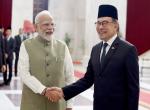When India became independent in 1947 it inherited a system of government which even today holds good. The basics of democracy and parliamentary government, separation of powers which gave the judiciary total autonomy in its own sphere, disciplined Armed Forces totally under civilian control, an organised and independent Civil Service and the rule of law are the positive legacy the British left us and it would be churlish not to acknowledge this. It would be equally silly on our part if we did not praise our leadership which readily accepted what was good and then nurtured these institutions. On the negative side, however, the British left us an economy which was quite rudimentary and where the infrastructure was almost infantile. Only about 5000 of our towns and villages were electrified, we had virtually no capital goods industry and in many ways we were a poor and primitive country.
Nehru was a man in a hurry to create the structure of a Modern State and a strong and forward looking economy. Power, transportation, healthcare, education, science and technology, our cultural heritage, participative rural development -- there was hardly any sector which Nehru did not cover. Parallel to the normal governmental administration was created a development administration to service the new Community Development Programme. The Civil Service was re-oriented to administer in the public interest rather than to merely rule. Nehru called for the building of the New Temples of a resurgent India, including huge dams for irrigation and hydel power, large thermal and hydro based power stations, steel plants, aluminium plants, copper and zinc plants, transportation systems, reinvigorated agriculture and educational institutions like the Indian Institutes of Technology, Indian Institutes of Management, the Indian School of Mines, massive Agriculture Universities, the All India Institute of Medical Sciences and the public sector which glavanised and synergised the economy.
Nehru was Prime Minister for seventeen years, a long tenure for the Prime Minister, but a very short episode in a country’s history. Twelve of these years can be called the core years because that is when the sinews of a strong economy and a modern nation were built. One can think of no comparable example, not even in the Soviet Union, of a country on the move in which Bhakra-Nangal, Hirakud, Chambal were built, Bhilai, Rourkela and Durgapur steel plants made operational, five IIsT and four IIsM, Punjab Agriculture University and the G. B. Pant Agriculture University were set up and India started making modern cars, aircraft and warships. If Modi can achieve even a fraction of this in the single matter of purifying the Ganga that would be praiseworthy. In the matter of Nehru’s achievements, I would rate them as miraculous.
Nehru is called a radical socialist whose development model was the Soviet system of planning. Nehru, by birth, was definitely upper class, apart from being a Brahmin who claimed to be agnostic, if not an atheist, but who retained his Brahmin intellectual mindset till the end. He was neither doctrinaire Marxist nor radical socialist. If anything he could be called a Fabian Socialist of the London School of Economics brand. He could never be a Stalinist dictator because he was a democrat who believed in the British style of parliamentary democracy. He opted for a planned economy not because he was a hardcore believer in dialectical materialism but because he had no other option. To modernise, India needed massive investment of capital. The private sector was not organised for this, did not have a scale large enough and in any case was too mercantile to believe in long term investment in long gestation projects. It is only the State which could encourage capital formation and, therefore, Nehru used the State to drive our economy. The private sector was not discouraged but it is the State which grabbed the initiative. The sheer speed of the transformation of the economy leaves us breathless even today.
The Nehruvian model can be tracked back even to the example of Japan at the time of the Meiji Revolution in the late nineteenth century. After Commodore Parry proved to Japan that a society mired in the science and technology of the medieval era was no match for a modern State, Japan decided to eliminate the Shogunate and go in for rapid modernisation. The State took the initiative in everything, including modernisation of the education system, the sending of young students abroad to learn modern science and technology, set up modern industry and build an economy which could catch up with the western world. The success of the modernisation drive can be gauged by the fact that in 1905 the Japanese Navy soundly defeated the dreadnoughts of the Imperial Russian Navy and proved that the new Japan was more than a match for any nation in the world.
The Japanese are a pragmatic people and they realised that having kick-started the economy the State could not be involved in micro managing it. The Japanese were fortunate to have great trading houses, the Zaibatsu, who could be brought in to take over the management of the newly established industries and then become the driving force of the economy as Japan jumped from the middle ages to the twentieth century. By the State intervening when it was necessary and pulling out when private enterprise could take over Japan became a great economic and military power. After Second World War Japan demilitarised itself, but it remained one of the most influential economic powers in the world, which it is even today. In India, unfortunately, after its initial virtual explosion of energy the public sector continued to dominate the economy, firstly because of its size, secondly because it was a part of the politico administrative system and thirdly because financial and other self interests, including patronage, became firmly entrenched and neither the politician, nor the bureaucrat, nor the public sector manager wanted the system to change. We blame Nehru for the inefficiency of the public sector, but we forget that Nehru died in 1964, at which time the public sector was still efficient. He chose his people carefully, including S.N. Mehta to build Bhilai, Harvey Slocum to build Bhakra-Nangal and P.N. Thapar and P.L. Verma to build Chandigarh. N. Dandekar created the Shipping Corporation of India and JRD Tata was persuaded to continue to head Air India even after it had been nationalised. The political rot which set in after Nehru’s death and the political takeover of the public sector as a source of patronage and corruption cannot be blamed on Nehru, which fact today’s Nehru bashers should keep in mind.
The highly westernised Kashmiri Pandit was the choice of that ascetic, Mahatma Gandhi, as the leader of independent India. The Mahatma recognised that if India was to retain and strengthen its secular democracy, if India was to modernise its economy, Nehru was the right choice as Prime Minister. People point to the 1962 Chinese invasion and the somewhat ill-advised offer of a plebiscite in Kashmir as two examples of Nehru’s weakness. Without going into the merit of this particular argument, can the trust reposed by a person in someone whom he considers a friend necessarily be a weakness? In any case if the Chinese had not invaded in 1962 Krishna Menon would have continued to be the Defence Minister, our armed forces would have been reduced to a laughing stock and we would have been hammered by Pakistan in 1965. The 1962 drubbing at the hands of the Chinese actually revived our armed forces, depoliticised them and made them a formidable fighting force. Anyway, trusting China and offering a plebiscite in Kashmir were Nehru’s weak spots, but the very fallibility of the man only strengthened his greatness as a person who could put India before his own self. Sometimes a weakness can also be a strength. Nehru was a total person and he has to be taken as a whole, individual mistakes notwithstanding, the subsequent degeneration of the public sector because of our own rigidities and cupidity of our leaders notwithstanding, Nehru followed the best path available to him to build India’s economy and he has to be given credit for the strengthening of our secular democracy and the modernisation of the Indian State.
Published Date: 15th April 2015, Image Source: http://www.walkthroughindia.com









Post new comment